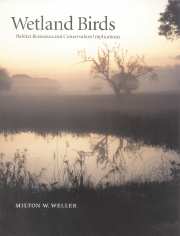Book contents
- Frontmatter
- Contents
- List of plates
- Preface
- Acknowledgments
- 1 Introduction
- 2 Wetlands: what, where, and why
- 3 Major groups of birds that use wetlands
- 4 Water and other resource influences
- 5 Foods, feeding tactics, strategies, and guilds
- 6 Bird mobility and wetland predictability
- 7 Other behavioral and physical influences on wetland living
- 8 Spatial and structural patterns
- 9 Habitat dynamics: water, plant succession, and time
- 10 Population consequences of wetland abundance and quality
- 11 How birds influence wetlands
- 12 Conservation implications
- 13 Measures of bird habitat use and quality
- 14 Current status and some conservation problems
- 15 Conservation and management strategies
- 16 Outlook
- 17 Epilogue
- Appendix 1 Scientific names of birds and bird groups
- Appendix 2 Scientific names of animals and animal groups other than birds
- Appendix 3 Scientific names of plants and plant groups
- Index of birds and bird groups
- Subject index
1 - Introduction
Published online by Cambridge University Press: 02 October 2009
- Frontmatter
- Contents
- List of plates
- Preface
- Acknowledgments
- 1 Introduction
- 2 Wetlands: what, where, and why
- 3 Major groups of birds that use wetlands
- 4 Water and other resource influences
- 5 Foods, feeding tactics, strategies, and guilds
- 6 Bird mobility and wetland predictability
- 7 Other behavioral and physical influences on wetland living
- 8 Spatial and structural patterns
- 9 Habitat dynamics: water, plant succession, and time
- 10 Population consequences of wetland abundance and quality
- 11 How birds influence wetlands
- 12 Conservation implications
- 13 Measures of bird habitat use and quality
- 14 Current status and some conservation problems
- 15 Conservation and management strategies
- 16 Outlook
- 17 Epilogue
- Appendix 1 Scientific names of birds and bird groups
- Appendix 2 Scientific names of animals and animal groups other than birds
- Appendix 3 Scientific names of plants and plant groups
- Index of birds and bird groups
- Subject index
Summary
The habitat perspective
Wetlands are unique biotic communities involving diverse plants and animals that are adapted to shallow and often dynamic water regimes. Here we focus on these systems as habitats for birds, viewing them as providers of the resources that birds need to survive and reproduce, but also as major forces in the evolution of their life-history strategies. As water is the key to wetland existence, the commonality of the birds considered here as wetland birds is their response to shallow waters, whether salty or fresh, and their use of water-based resources. Wetland birds are extremely diverse, reflecting early anatomical and physiological adaptations to this unique but rich habitat. Several birds are among the few ancient ancestors that survived whatever cataclysmic events caused the die-off of the dinosaurs (Gibbons 1997), strongly suggesting that a wet habitat was a good place to be early in the history of bird evolution, and that it still is. This attraction and response by birds to such shallow water is conspicuous and much studied; however, in addition to its inherent value to birds, water also reflects the status of other resources in a habitat at a given time. Many ecologists feel that birds are one of the more visible indicators of the total productivity of such biotic systems.
The advantage of taking a habitat perspective of a large group of diverse birds is that it helps to explain some of the ecological and evolutionary mechanisms that have dictated bird form and function. The habitat view has grown in importance but it is not new. Students of wetland birds early in the 20th century recognized the link between habitat and bird life history, but the focus often was on single species.
- Type
- Chapter
- Information
- Wetland BirdsHabitat Resources and Conservation Implications, pp. 1 - 12Publisher: Cambridge University PressPrint publication year: 1999
- 1
- Cited by



